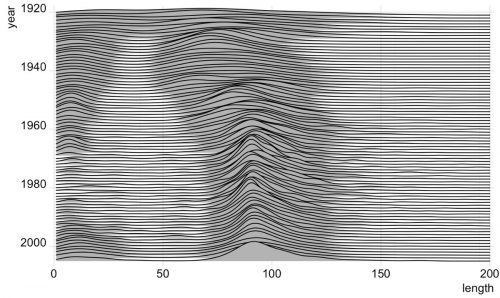
One of the big themes in social theory is rationalization—the idea that people use institutions, routines, and other formal systems to make social interaction more efficient, but also less flexible and spontaneous. Max Weber famously wrote about bureaucracy, especially how even the most charismatic or creative individuals would eventually come to rely on stable routines. More recent works highlight just how much depend on rationalization in government, at work, and in pop culture.
With new tools in data analysis, we can see rationalization at work. Integrative Biology professor Claus Wilke (@ClausWilke) recently looked at a database of movies from IMDB since 1920. His figure (called a joyplot) lets us compare distributions of movie run times and see how they have changed over the years.

While older films had much more variation in length, we can see a clear pattern emerge where most movies now come in just shy of 100 minutes, and a small portion of short films stick to under 30. The mass market movie routine has clearly come to dominate as more films stick to a common structure.
What’s most interesting to me is not just these two peaks, but that we can also see the disappearance and return of short films between 1980 and 2010 and the some smoothing of the main distribution after 2000. Weber thought that new charismatic ideas could arise to challenge the rationalized status quo, even if those ideas would eventually become routines themselves. With the rise of online distribution for independent films, we may be in the middle of a new wave in charismatic cinema.
This article was originally published by Sociological Images under a CC-BY-NC-SA licence


Rate and Review
Rate this article
Review this article
Log into OpenLearn to leave reviews and join in the conversation.
Article reviews